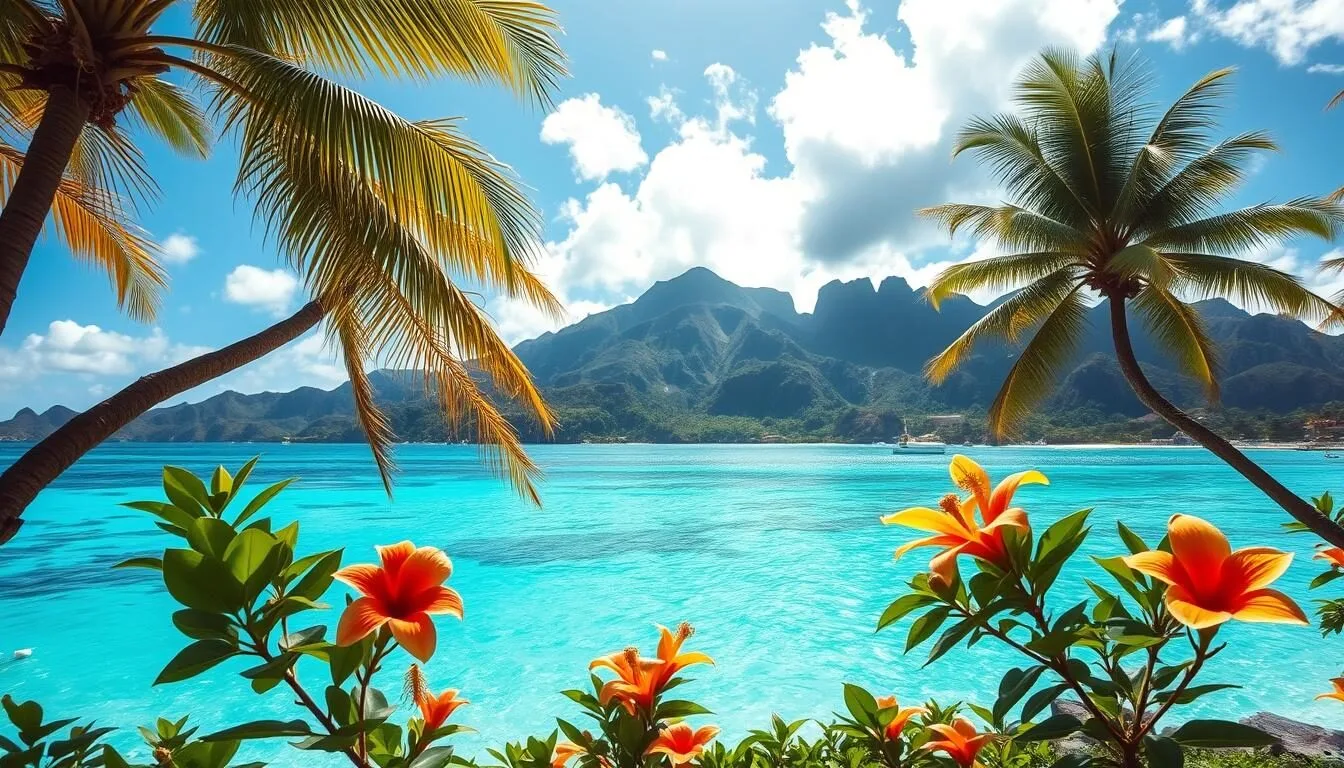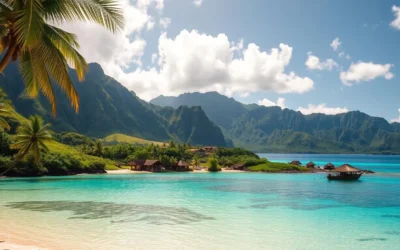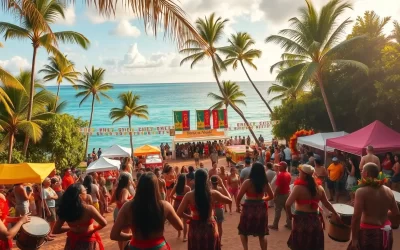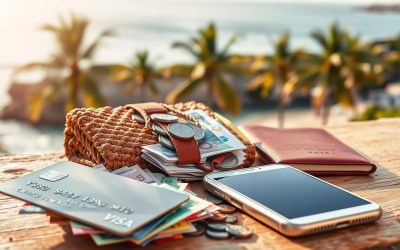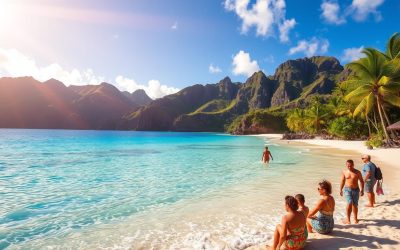Nestled in the heart of the South Pacific, American Samoa is a hidden gem waiting to be explored. With its remote location, this U.S. territory remains one of the most untouched destinations, offering a unique blend of stunning natural landscapes and rich Polynesian culture.
As you plan your trip to this island paradise, you’ll discover a wealth of unforgettable experiences. From the National Park of American Samoa to secluded beaches and cultural immersion, this comprehensive guide will walk you through the top things to do and see in American Samoa. Whether you’re looking for adventure or relaxation, this guide will help you make the most of your time in this remarkable destination.
Discovering American Samoa: An Untouched Pacific Paradise
As one of the most remote U.S. territories, American Samoa beckons travelers to explore its untouched landscapes. Located in the heart of the South Pacific, this hidden gem offers a unique blend of natural beauty and rich cultural heritage.
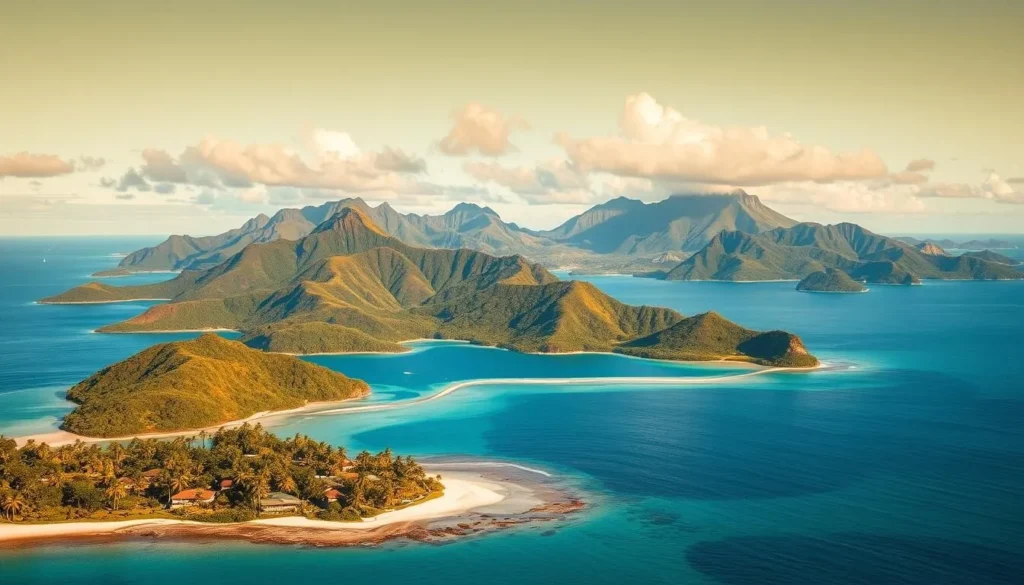
Where is American Samoa Located?
American Samoa is situated approximately halfway between Hawaii and New Zealand, making it one of the most isolated U.S. territories. It is located south of the equator and just east of the International Date Line, giving it a distinct geographical position. This unique location contributes to its untouched beauty and diverse ecosystems.
The territory comprises five main islands and two atolls, with Tutuila being the largest and most populated island. Pago Pago, the capital, is located on Tutuila, offering a picturesque harbor and a glimpse into the local culture.
The Islands of American Samoa
The islands of American Samoa are characterized by lush rainforests, pristine beaches, and vibrant coral reefs. The territory’s diverse landscapes are protected in part by the National Park of American Samoa, which was established in 1988 to preserve the natural ecosystem and traditional Samoan culture across parts of three islands.
Visitors can explore the islands’ natural beauty, from the rugged terrains to the serene beaches, each offering a unique experience.
Brief History and Culture
The history of American Samoa dates back approximately 3,000 years ago when the first Polynesian settlers arrived from Southeast Asia, establishing what would become the oldest Polynesian culture. In 1900, American Samoa became a U.S. territory, primarily for its strategic naval location. Despite its association with the United States, the territory has maintained its strong Samoan cultural identity through the concept of “Fa’a Samoa” (the Samoan Way).
How to Get to Pago Pago, American Samoa
Traveling to Pago Pago, American Samoa, requires some planning due to its remote location in the Pacific. Understanding the flight options and schedules is crucial for a smooth trip.
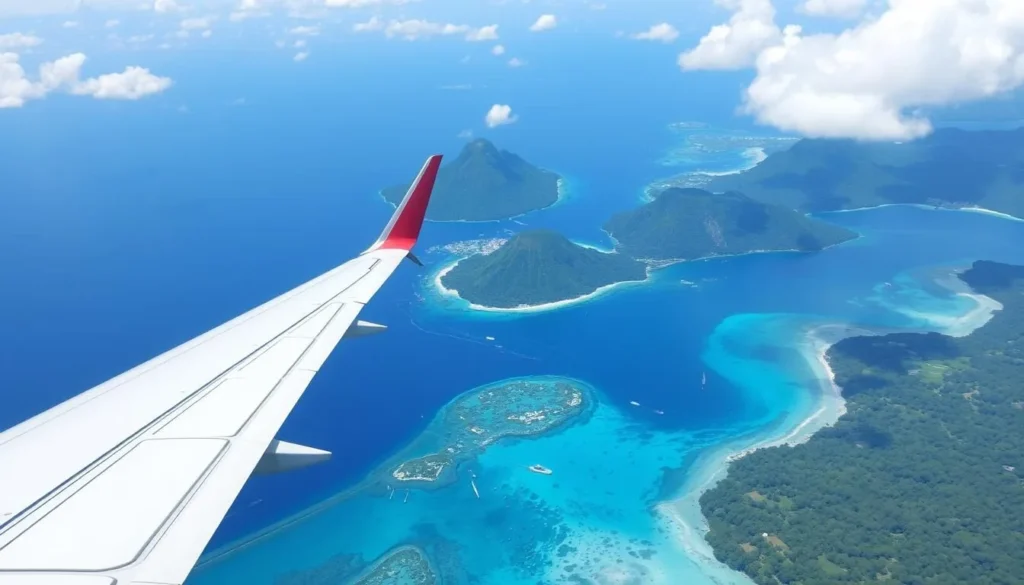
Flight Options from the United States
If you’re traveling from the mainland United States, you’ll need to connect through Honolulu, Hawaii, which serves as the primary gateway to American Samoa. Hawaiian Airlines offers flights from Honolulu to Pago Pago two to three times a week, usually on Monday, Tuesday, and Thursday. This limited flight schedule requires travelers to plan ahead and be flexible with their travel dates.
Flights from Other Pacific Islands
For travelers coming from Australia, New Zealand, or other Pacific nations, you can first fly to Samoa or Tonga, then take a short connecting flight to American Samoa. Talofa Airways operates small 8-passenger planes between Samoa and American Samoa, offering a quick 30-minute flight that provides spectacular views of the islands.
Crossing the International Date Line
When flying from Samoa to American Samoa, you’ll experience the unique phenomenon of crossing the International Date Line, essentially traveling back in time as you arrive earlier on the calendar than when you departed. For instance, a flight from Apia, Samoa on Wednesday at 10:00 am can land in Pago Pago on Tuesday at 10:30 am, a fascinating experience for travelers.
It’s essential to be aware that the limited flight options can affect your itinerary flexibility, so booking well in advance and building in buffer days is highly recommended. Additionally, cruise ships occasionally visit Pago Pago harbor, offering another way to experience American Samoa, though typically for just a day visit.
Best Time to Visit Pago Pago
To make the most of your trip to Pago Pago, it’s essential to know when to go. American Samoa’s climate and cultural events play a significant role in determining the best time for a visit.
Weather and Seasons
The best time to visit Pago Pago and American Samoa is during the dry season, from May to October. During this period, rainfall is less frequent, and temperatures average a pleasant 80-85°F (27-29°C), making it ideal for outdoor activities and exploring the island. In contrast, the wet season from November to April brings higher humidity and more frequent rainfall, though many days still offer plenty of sunshine.
| Season | Months | Weather Conditions |
|---|---|---|
| Dry Season | May – October | Less rainfall, 80-85°F (27-29°C) |
| Wet Season | November – April | Higher humidity, more rainfall |
Cultural Events and Festivals
American Samoa hosts several cultural events throughout the year. One of the most significant celebrations is Flag Day on April 17, which features traditional dance competitions, canoe races, and cultural demonstrations. Timing your visit to coincide with these events can enrich your experience.
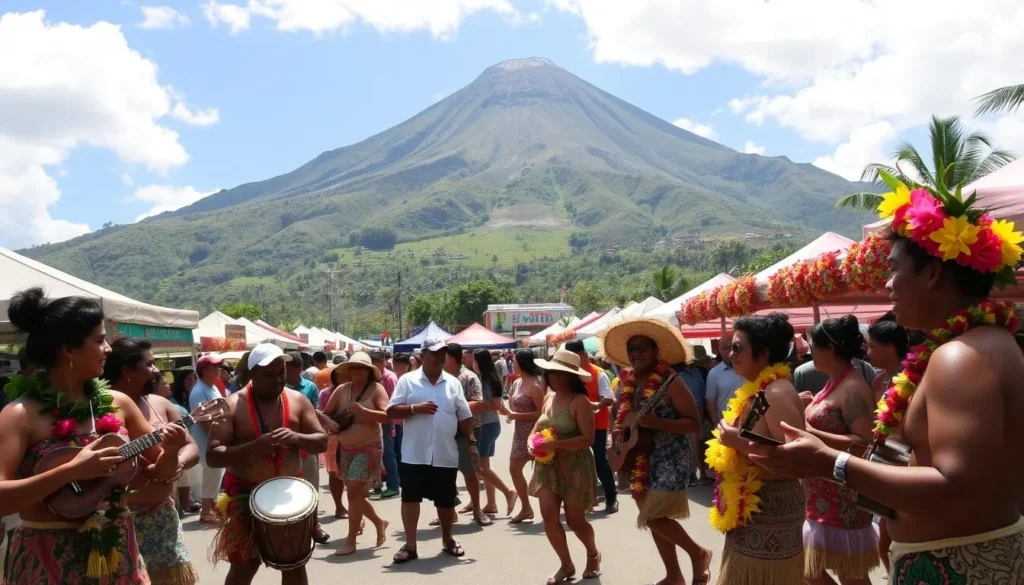
Tourism Considerations
Tourism in American Samoa remains relatively undeveloped, meaning fewer crowds year-round. However, this also means more limited infrastructure. Three days on Tutuila Island gives you enough time to explore the main attractions, though adding extra days allows for a more relaxed pace and the possibility of day trips. Be aware that during major American or Samoan holidays, many businesses and attractions may operate on reduced hours or close entirely, especially on Sundays.
The shoulder seasons of April-May and September-October often provide the best balance of good weather, fewer rain showers, and relatively lower humidity for outdoor activities.
Cultural Etiquette: Respecting Fa’a Samoa
Fa’a Samoa, a cultural code that has been part of island life for thousands of years, is something you should understand and respect during your visit. American Samoa’s rich culture is deeply rooted in its history, dating back about 3,000 years when the first people from Southeast Asia arrived on the Samoan islands. This ancient culture places a strong emphasis on family, community values, and Christian religion. As a visitor, being mindful of and respecting these cultural norms will enhance your experience and interactions with the local community.
Dress Code and Modesty
When visiting villages or public areas, you should dress modestly. Men are expected to wear shirts, while women should cover their shoulders and knees, typically with a lavalava (sarong) or longer shorts/skirts. This modest dress code is a sign of respect for the local culture and customs. When you’re on a beach or by the pool, you can dress more casually, but it’s advisable to cover up when you’re not in these areas.
Village Protocols
Before entering a village or taking photographs of people or their property, you should always ask permission first as a sign of respect. If you’re invited to a traditional Samoan home (fale), you’ll need to remove your shoes before entering and sit cross-legged on the floor mats. It’s also customary to avoid eating or drinking while walking through villages. Many beaches are family or village property, and you may need to ask permission to visit them, potentially for a small fee.
Sunday Observances
Sunday is strictly observed as a day of rest and worship throughout American Samoa. Most businesses are closed, transportation options are limited, and many beaches on village land are inaccessible. Respecting this day of rest is crucial to being a considerate visitor. You could get a deeper understanding of the local culture by participating in or observing the Sunday services, which are an integral part of the community’s spiritual life.
| Cultural Norm | Description |
|---|---|
| Dress Modestly | Cover shoulders and knees when visiting villages or public areas. |
| Ask Permission | Before taking photos or entering villages and private properties. |
| Respect Sunday | Observe Sunday as a day of rest, with limited activities and closed businesses. |
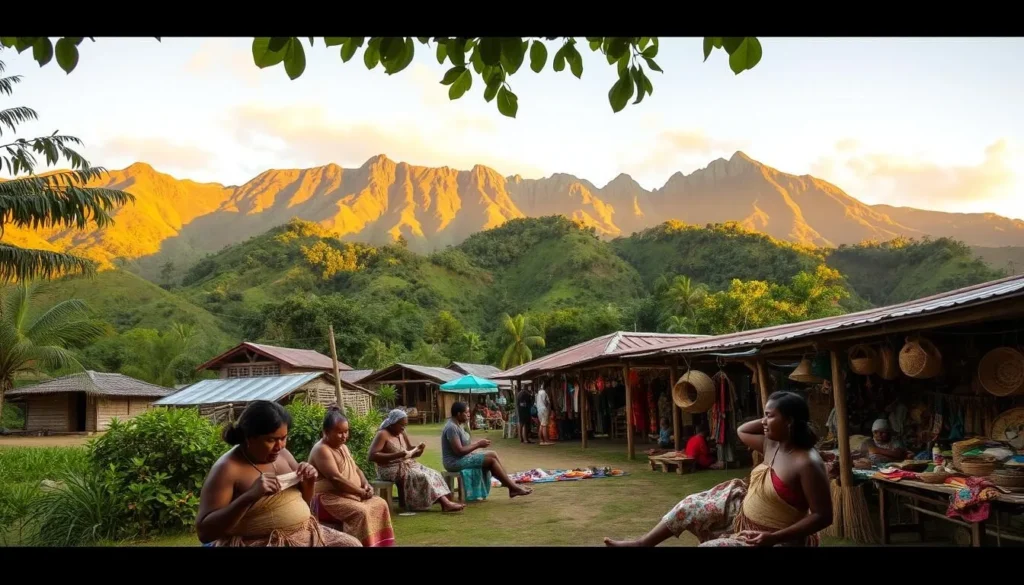
By understanding and respecting Fa’a Samoa, you’ll not only have a more meaningful experience during your visit to American Samoa, but you’ll also contribute to preserving this rich cultural heritage. This island community values its traditions, and your respect will be appreciated. Fa’a Samoa has been an integral part of the Samoan way of life for years ago, and continuing to respect it will make your time on the island more enjoyable.
Exploring the National Park of American Samoa
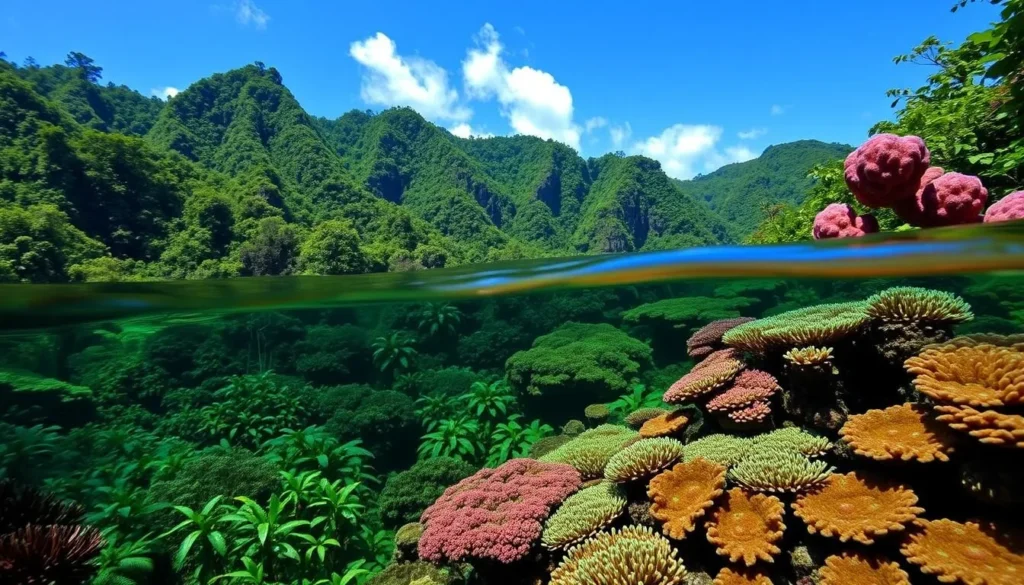
The National Park of American Samoa, located south of the equator, is a hidden gem waiting to be explored. As the only U.S. national park in the southern hemisphere, it offers a unique experience, blending natural beauty with cultural heritage across three islands: Tutuila, Ofu, and Ta’u.
Park Overview and History
The National Park of American Samoa was established on November 1, 1988, to preserve the region’s tropical rainforests, coral reefs, and the fa’asamoa (Samoan way of life). Spanning across three islands, it is one of the least visited national parks in the U.S., with only about 12,000 visitors annually. This relative isolation makes it an ideal destination for those seeking an unspoiled and serene environment.
Pola Island and Vai’ava Strait Viewpoint
One of the park’s highlights is the Pola Island and Vai’ava Strait Viewpoint, accessible with minimal hiking from a convenient parking area. This viewpoint offers spectacular panoramic views of Pola Island and the Vai’ava Strait National Natural Landmark, making it a must-visit for anyone exploring the park.
Lower Sauma Ridge Trail
For those looking to hike, the Lower Sauma Ridge Trail is a short but rewarding 0.4-mile round trip hike with moderate difficulty. It takes you to the tip of a peninsula, offering stunning views of Pola Island and the surrounding coastline. The trail is a great introduction to the park’s natural beauty, with an elevation gain of 175 feet and a completion time of 30 to 45 minutes.
Mount ‘Alava Adventure Trail
For more adventurous hikers, the Mount ‘Alava Adventure Trail provides a challenging experience, featuring 56 ladders and nearly 800 steps that descend from Mount ‘Alava to Vatia village. This trail is not for the faint of heart but offers a unique perspective on the island’s landscape and is a thrilling way to explore the park’s diverse ecosystems.
The National Park of American Samoa is not just a natural wonder but also a cultural treasure, preserving the fa’asamoa and creating a unique partnership between the National Park Service and Samoan communities. Unlike most national parks, portions of this park are leased from local villages, highlighting the collaborative effort in its conservation.
Pago Pago, American Samoa: Best Things to Do – Top Picks
The heart of American Samoa beats in Pago Pago, a majestic harbor surrounded by lush landscapes. As you explore this stunning natural haven, you’ll discover a plethora of attractions and activities that make Pago Pago a must-visit destination.
Pago Pago Harbor Highlights
Pago Pago Harbor is one of the most spectacular natural harbors in the South Pacific, serving as the heart of American Samoa and offering several must-see attractions along its scenic shoreline. As you drive along Route 001, you’ll encounter various points of interest that showcase the harbor’s beauty and significance.
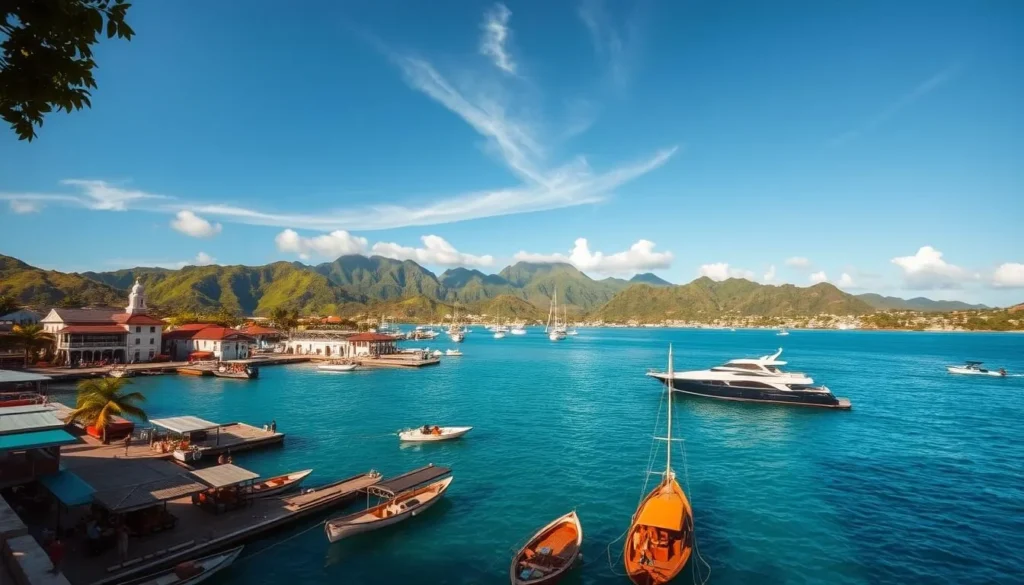
Jean P. Haydon Museum
The Jean P. Haydon Museum is a treasure trove of American Samoa’s history and culture. Established in 1970, this small museum contains artifacts over 450 years old, as well as moon rocks from the US Apollo Space Missions. Visiting this museum provides a unique insight into the island’s rich heritage and its role in the space program.
National Marine Sanctuary Visitor Center
The National Marine Sanctuary Visitor Center is a great place to learn about the protected marine environment surrounding American Samoa. The center offers interactive exhibits that highlight the importance of preserving the island’s pristine coral reefs and marine life. By visiting this center, you’ll gain a deeper appreciation for the region’s natural beauty and the efforts to conserve it.
Historic Tramway Site
The Historic Tramway Site is a fascinating piece of American Samoa’s history. In the 1960s, a tramway carried people from the harbor to the top of Mount ‘Alava. Although the tramway was damaged in a 1992 hurricane and never repaired, one of the original tramway cars remains on a hillside overlooking Pago Pago Harbor. A short uphill walk from the tramway car leads to a pavilion with a stunning view of the harbor.
WWII Historical Sites
American Samoa played a significant strategic role during World War II, and the harbor area is home to several historical sites that reflect this period. You can explore gun emplacements and bunkers that tell the story of the island’s involvement in the war. These sites offer a glimpse into the island’s history and the importance of the harbor during that time.
| Attraction | Description | Location |
|---|---|---|
| Jean P. Haydon Museum | Historical museum with artifacts and moon rocks | Pago Pago Harbor area |
| National Marine Sanctuary Visitor Center | Interactive exhibits on marine conservation | Pago Pago Harbor area |
| Historic Tramway Site | Remains of the old tramway with panoramic views | Mount ‘Alava |
| WWII Historical Sites | Gun emplacements and bunkers from WWII | Around Pago Pago Harbor |
By exploring these attractions, you’ll experience the best of what Pago Pago has to offer. Whether you’re interested in history, nature, or culture, there’s something for everyone in this beautiful harbor town.
Best Beaches in and Around Pago Pago
Discover the unspoiled beauty of American Samoa’s beaches, a hidden gem in the Pacific. The beaches around Pago Pago offer a mix of relaxation, adventure, and cultural experiences that are sure to make your visit unforgettable.
Fatumafuti Beach
Fatumafuti Beach is a small, picturesque beach with a gorgeous view across Pago Pago Harbor. It’s considered one of the best snorkeling spots on Tutuila Island, thanks to its clear waters and diverse marine life. The beach is open from Monday through Saturday, 6 am to 6 pm, and is a great spot to enjoy the local scenery.
Two Dollar Beach
Two Dollar Beach, also known as “Tutuila’s $5 Beach,” offers a classic tropical beach experience. With its white sand, swaying palm trees, and crystal-clear waters, it’s perfect for swimming, relaxation, and soaking up the sun. This beach is a must-visit for anyone looking for a traditional island experience.
Alega Beach and Tisa’s Barefoot Bar
Alega Beach is home to the famous Tisa’s Barefoot Bar, a rustic, open-air establishment that serves fresh seafood and local specialties. It’s not just a great place to enjoy authentic Samoan cuisine, but also to experience the local culture. Tisa herself is a local cultural ambassador who has appeared on travel shows, adding to the bar’s charm.
Hidden Beaches Worth Discovering
Many of American Samoa’s most beautiful beaches are hidden gems that require permission to visit, as they are located on family or village land. Exploring these beaches not only offers seclusion and pristine environments but also provides opportunities to interact with locals and experience authentic Samoan hospitality. Beaches like those in Fagatele Bay within the National Park are worth discovering.
Wildlife Encounters in American Samoa
In American Samoa, you’ll have the opportunity to witness an array of wildlife, from flying foxes to vibrant coral reefs. The National Park of American Samoa is a haven for diverse wildlife, making it an ideal destination for nature lovers and those seeking unique wildlife encounters.
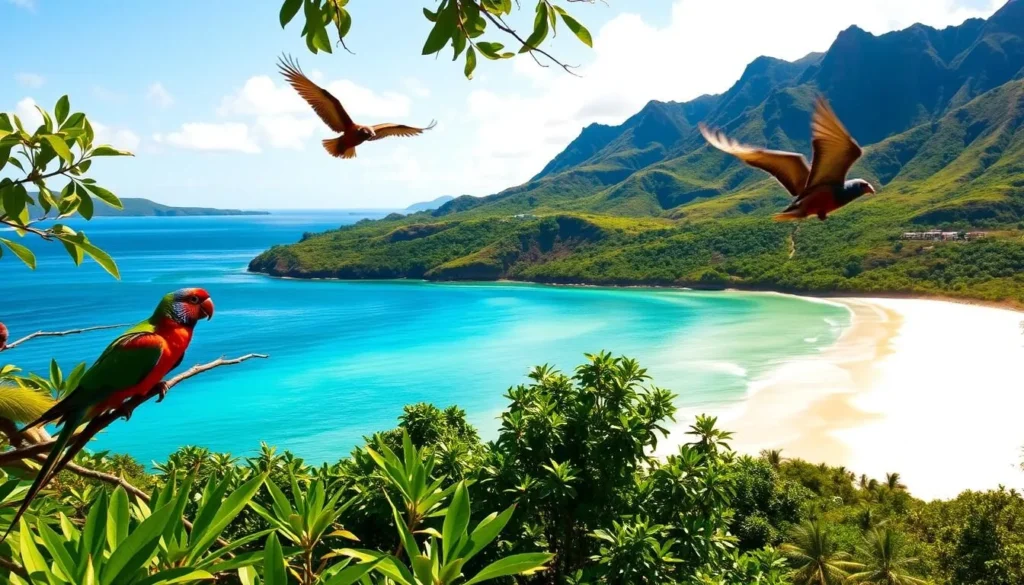
Spotting Flying Foxes (Fruit Bats)
One of the park’s most distinctive animals is the Samoan flying fox, also known as the fruit bat. These creatures can be easily spotted at a specific tree near the intersection of Routes 001 and 006. To visit, park in the wide, sandy lot on Route 001, marked on Google Maps at the GPS coordinates 14°16’12.6″S 170°39’57.3″W. The tree is just across the street and to the right, accessible within a minute’s walk.
Marine Life and Coral Reefs
The waters around American Samoa are home to an extraordinary array of marine life. The National Park and National Marine Sanctuary protect coral reefs that house over 800 species of fish and 200 species of coral. When snorkeling or diving at beaches throughout the islands, you might encounter sea turtles, colorful tropical fish, and some of the oldest and largest Porites coral heads in the world.
Bird Watching Opportunities
Bird watching enthusiasts can spot tropical species like the Samoan starling, wattled honeyeater, and Pacific pigeon in the rainforests. Along the coastlines, seabirds such as frigatebirds and tropicbirds can be seen. The National Park of American Samoa offers a unique opportunity to observe the connection between land and sea in a tropical rainforest setting.
- Unique wildlife viewing opportunities, including massive fruit bats and vibrant coral reef ecosystems.
- Convenient parking area on Route 001 for bat watching.
- Trails in the national park for forest birds.
- Beaches with healthy coral for marine life.
Scenic Viewpoints Not to Miss
As you explore the island of Tutuila, you’ll discover breathtaking viewpoints that showcase American Samoa’s natural beauty. The island is dotted with scenic lookouts that offer stunning vistas of the surrounding landscapes, making them a must-visit for any traveler.
A’oloaufou Mountain View
A’oloaufou Mountain View provides a breathtaking aerial perspective of southern Tutuila Island. To reach this viewpoint, drive up Route 002 towards the village of A’oloau. Look for the concrete archways at a hairpin bend just before reaching Maria Le Tina, Aoloau, and A’asu Catholic Church. If you park next to the historic tramway car, a short uphill walk will take you to a pavilion with a panoramic view over Pago Pago Harbor. This viewpoint is one of the easiest ways to get an aerial view of the harbor with little to no hiking.
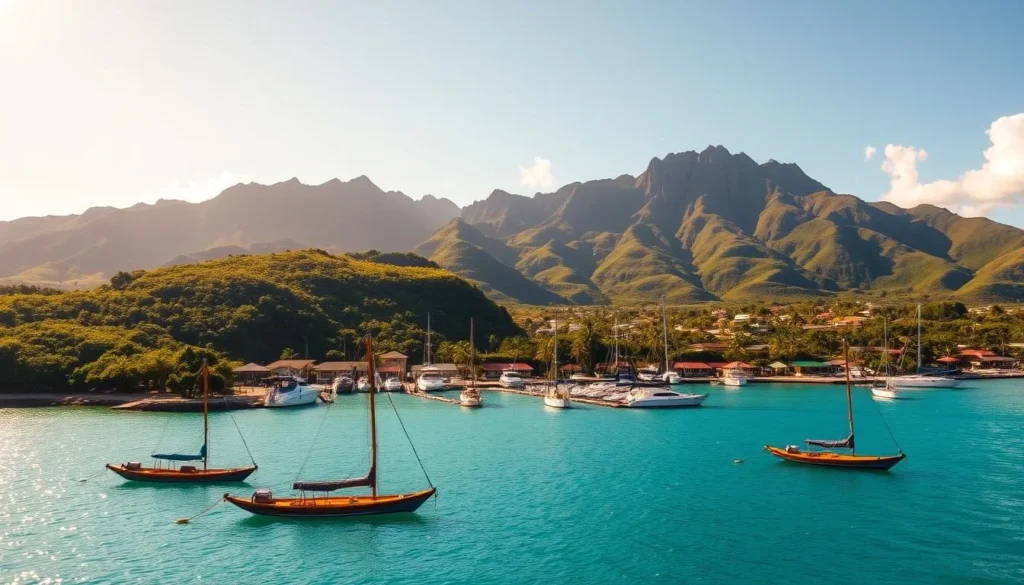
Rainmaker Mountain
Rainmaker Mountain, also known as Mount Pioa, is a dominant feature around Pago Pago Harbor, creating the island’s distinctive weather patterns. While hiking to its summit is challenging, you can enjoy views of this iconic peak from multiple vantage points around the harbor. The mountain’s lush vegetation and rugged terrain make it a striking feature of the island’s landscape.
Pago Pago Harbor Lookouts
Several lookouts around Pago Pago Harbor offer spectacular views with minimal effort. The historic tramway site is one such location, where a short uphill trail leads to a pavilion with panoramic harbor views. For those willing to make a moderate uphill hike, the Blunts Point Trail also provides excellent views of the harbor. For the best photography opportunities, visit these viewpoints in the early morning or late afternoon when the light accentuates the deep blues of the harbor against the lush green mountains. You can use Google Maps to locate these viewpoints, and don’t hesitate to ask locals or park rangers for recommendations on the best spots to visit.
Hidden Gems: Off the Beaten Path
Beyond the usual tourist spots, American Samoa conceals a wealth of natural beauty and cultural significance. For those willing to explore, the island offers a range of hidden gems that are sure to leave a lasting impression.
Turtle and Shark Site
The Turtle and Shark Site is a dramatic coastline featuring black volcanic rocks and white sandy beaches. The powerful waves crashing against the cliffs create a mesmerizing display of nature’s force. However, visitors must exercise caution when exploring this area. The rocks can be slippery, and rogue waves can pose a significant threat. Additionally, there’s a blowhole in the area that can be dangerous if not approached carefully. Be sure to spot the blowhole’s location before stepping onto the rocks and maintain a safe distance.
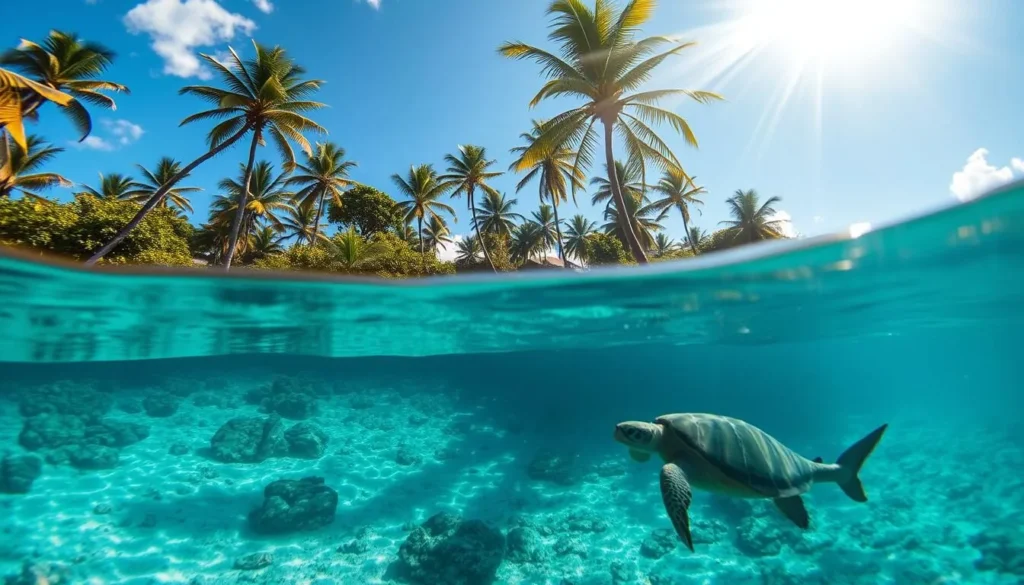
Fagatele Bay
Fagatele Bay is a secluded cove with a small, hidden beach, perfect for those seeking solitude. The bay is nestled within a collapsed volcanic crater and is now part of the National Marine Sanctuary of American Samoa. Visitors can enjoy swimming and snorkeling in the bay’s crystal-clear waters. To access Fagatele Bay, you’ll need to take a 1.5-mile trail through private property, for which a fee of $10 per person is required. It’s advisable to have cash ready, as not all places may accept other payment methods.
Larsen Bay
Larsen Bay offers another hidden beach experience, comprising two beautiful coves known as Fogama’a and Fagalua. These coves are part of the National Marine Sanctuary, providing a serene and picturesque setting. To reach Larsen Bay, you’ll need to navigate rough roads and pay a small fee to cross private land. Using Google Maps can help you find the general location, but local directions may be necessary for the final approach.
Exploring these off-the-beaten-path destinations in American Samoa typically requires a rental car, but the reward is having these stunning locations almost to yourself. In today’s world of overtourism, experiencing such seclusion is a rare treat. So, take the road less traveled and discover the unspoiled beauty of American Samoa.
Day Trip to the Manu’a Islands
Located 110 kilometers east of Tutuila, the Manu’a Islands are a remote paradise waiting to be explored. These islands offer a unique blend of untouched beaches, lush mountainous rainforests, and pristine coral reefs perfect for snorkeling.
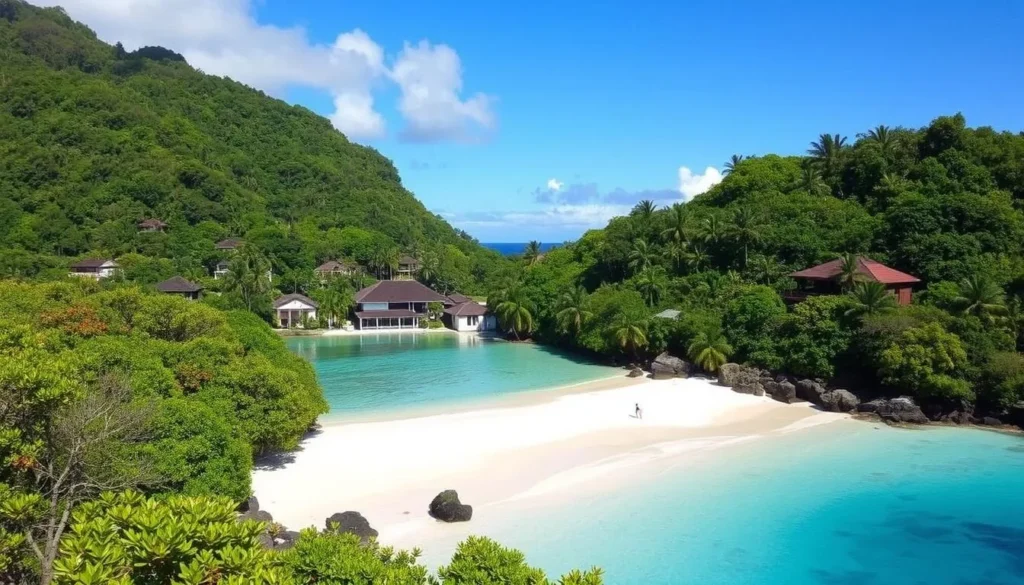
Getting to Ofu and Ta’u
Getting to the Manu’a Islands requires careful planning due to the limited flight schedule. Samoa Airways currently offers two flights per week between Tutuila and Ofu, on Tuesdays and Thursdays. This means you can plan a short trip by going on Tuesday and returning on Thursday, or stay for a longer period.
Ofu Beach: One of the World’s Most Beautiful Beaches
Ofu Beach, part of the National Park of American Samoa, is renowned for its pristine white sand and dramatic mountains. The beach is fronted by some of the healthiest coral reefs in American waters, making it a perfect spot for snorkeling and exploring marine life.
Hiking Opportunities on the Manu’a Islands
The Manu’a Islands offer several hiking trails, including the challenging Tumu Mountain Trail on Ofu, which rewards hikers with breathtaking views of the beach below. On Ta’u Island, you can hike to ancient Samoan cultural sites and explore the southeastern portion of the National Park.
Accommodation Options
Accommodation on the Manu’a Islands is extremely limited, with only two small properties on Ofu: Vaoto Lodge and Asaga Inn. It’s essential to make advance reservations to secure your stay. A trip to the Manu’a Islands typically requires a minimum of 3-4 days, allowing you to experience the tropical isolation and natural beauty that these islands offer.
Where to Stay in Pago Pago
When planning your trip to Pago Pago, American Samoa, choosing the right accommodation is crucial for a comfortable stay. You’ll find that accommodation options in American Samoa are limited but sufficient, with the Tradewinds Hotel and Sadie’s by the Sea being the two main properties catering to international visitors.
Tradewinds Hotel
The Tradewinds Hotel, located near the airport in Tafuna, offers the island’s most modern accommodations with amenities including a restaurant, pool, and fitness center, making it ideal for business travelers or those who prioritize comfort. Its proximity to the airport makes it convenient for late arrivals or early departures.
Sadie’s by the Sea
Sadie’s by the Sea provides a more authentic island experience with its oceanfront location, small private beach, and central position that makes it convenient for exploring both the eastern and western parts of the island. The staff at Sadie’s is extremely friendly, and they are all bilingual in English and Samoan.
Other Accommodation Options
For longer stays, you might consider the limited vacation rental options on the island, though these require booking well in advance and often a rental car is necessary due to their locations. Whichever accommodation you choose, you’ll appreciate the genuine Samoan hospitality that makes up for any shortcomings in the physical facilities.
Where to Eat: Best Restaurants in Pago Pago
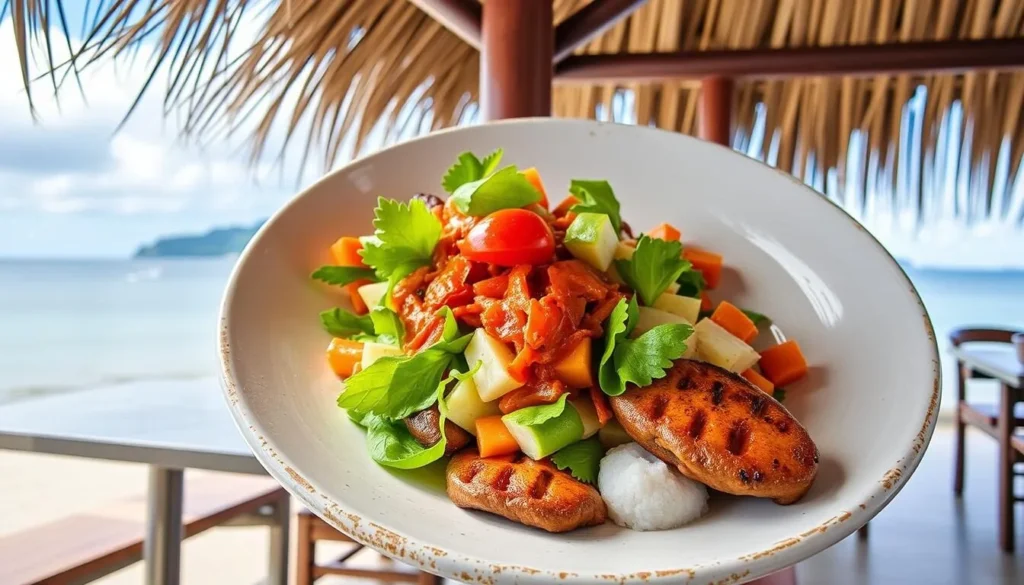
Dining in Pago Pago is a culinary journey through American Samoa’s unique blend of Pacific and American cultures. As you explore the capital, you’ll find a variety of dining options that reflect both traditional Samoan cuisine and American influences, with a focus on fresh seafood and tropical ingredients.
Local Samoan Cuisine
Local Samoan cuisine is a highlight of dining in Pago Pago, featuring specialties like oka (raw fish marinated in coconut milk) and palusami (taro leaves with coconut cream). You should also try various preparations of taro, breadfruit, and fresh seafood, which are staples in Samoan cooking. These dishes offer a genuine taste of American Samoa’s rich cultural heritage.
Top Restaurant Recommendations
One of the standout dining experiences in Pago Pago is Tisa’s Barefoot Bar, located on Alega Beach. This rustic beachfront restaurant serves authentic Samoan dishes in a relaxed, tropical setting. It’s a must-visit for anyone looking to enjoy local flavors in a picturesque environment. Be sure to check out their menu, which often includes fresh catches of the day and traditional Samoan specialties.
Dining Etiquette and Tips
When dining out in Pago Pago, be aware that restaurant hours can be limited, with many places closed on Sundays. Some establishments may also unexpectedly close or run out of menu items, so it’s a good idea to plan ahead. Additionally, due to the island’s 20-25 mph speed limits and winding roads, even short distances can take considerable time to travel. Unlike in the mainland US, tipping is not customary in American Samoa, though you can leave a small gratuity for exceptional service if you wish.
For budget-conscious travelers, the local markets offer fresh produce and prepared foods that provide both authentic flavors and value, while giving you insight into everyday Samoan life. Enjoy exploring the dining options in Pago Pago and experiencing the unique culinary delights of American Samoa.
Getting Around American Samoa
Navigating American Samoa requires some planning, but with the right transportation, you can explore this Pacific paradise with ease. The island’s scenic beauty and cultural attractions are spread out, making transportation a key aspect of your trip.
Rental Car Options
Having your own transportation is the most convenient way to explore American Samoa. Rental car options are available through local companies, and it’s highly recommended to make advance reservations, especially during peak travel periods or events like Flag Day celebrations. Be prepared for strictly enforced speed limits of 20-25 mph, which can make journeys longer than expected. With a rental car, you can enjoy the scenic routes at your own pace and stop at viewpoints and attractions along the way.
| Rental Car Company | Vehicle Types | Reservation Recommendation |
|---|---|---|
| Local Samoa Rentals | Compact, SUV | Strongly Recommended |
| Pacific Island Car Rentals | Sedan, 4WD | Highly Advised |
Public Transportation
For a more authentic experience, you can use the colorful “aiga” buses that operate throughout the island. These buses are not only affordable, costing just $1 per ride, but they also offer a glimpse into local life. To use this service, simply wave your hand with your palm facing down to signal the bus to stop, and knock on the window when you want to get off. While the schedules can be loose and primarily cater to local commuters, it’s a great way to see the island and interact with the friendly locals.
Walking and Hiking Considerations
Walking is a viable option in and around Pago Pago, allowing you to enjoy the local scenery and culture. However, for exploring national parks and more remote areas, you’ll need to consider other transportation options due to the tropical heat, occasional heavy rainfall, and limited sidewalks. Hiking trails in American Samoa can be challenging due to the climate and sometimes overgrown conditions, so it’s essential to be prepared with appropriate gear and planning.
By choosing the right transportation method, you can make the most of your visit to American Samoa, enjoying its natural beauty, cultural richness, and warm hospitality.
Practical Tips for Visiting American Samoa
To make the most of your visit to American Samoa, it’s essential to be prepared. With its unique culture, stunning natural beauty, and relaxed atmosphere, American Samoa is a wonderful destination for travelers. Here are some practical tips to help you navigate your trip.
Currency and Banking
American Samoa uses the US dollar as its currency, making it easy for American travelers to manage their finances. However, it’s crucial to bring sufficient cash, as ATMs are limited and not all businesses accept credit cards. You should also be aware that some local businesses may not accept large denomination bills, so it’s a good idea to have some smaller bills on hand.
Internet and Communication
Internet access is available in American Samoa, but it can be slow and unreliable, particularly outside of the main areas. To stay connected, download maps, guides, and entertainment before your arrival, and inform your loved ones that you may have limited communication during your stay. You can also consider purchasing a local SIM card or portable Wi-Fi hotspot for more reliable internet access.
Health and Safety
As a US territory, American Samoa is generally a safe destination, but you should still take standard precautions to secure your valuables and be mindful of your surroundings. Medical facilities are basic, so it’s recommended to have travel insurance with evacuation coverage in case of an emergency. You should also be aware of the risk of dengue fever and Zika virus, and take necessary precautions to avoid mosquito bites.
Packing Essentials
When packing for American Samoa, be sure to include reef-safe sunscreen, insect repellent, modest clothing for village visits, a good rain jacket (regardless of the season), and water shoes for exploring beaches and coral areas. You should also pack light, breathable clothing and comfortable walking shoes. Don’t forget to bring a power adapter, as the power outlets in American Samoa are the same as those in the US.
With these practical tips, you’ll be well-prepared for your trip to American Samoa. Whether you’re spending three days on Tutuila or exploring the Manu’a Islands, being aware of the local customs, culture, and infrastructure will help you make the most of your time on this beautiful island.
Conclusion: Making the Most of Your Visit to Pago Pago
Exploring American Samoa is like stepping into a world of breathtaking beauty and untouched culture. As you plan your trip, you’ll discover a unique blend of natural beauty, rich Polynesian culture, and the distinction of visiting America’s most remote territory.
The National Park of American Samoa should be the centerpiece of your visit, with its diverse trails, stunning views, and rare wildlife making it unlike any other national park in the US system. If you’re an avid hiker, consider conquering the Mount ‘Alava Adventure Trail, which offers breathtaking views of the surrounding landscape.
While Tutuila Island can be explored in three days, consider extending your trip to include the Manu’a Islands if time permits. Ofu Beach is frequently cited as one of the world’s most beautiful beaches, and the hiking opportunities on the Manu’a Islands are unparalleled.
American Samoa works well as part of a larger South Pacific itinerary, with relatively easy connections to independent Samoa, Hawaii, Tonga, or Fiji. This allows you to experience different Polynesian cultures and create unforgettable memories.
The memories you’ll treasure most from American Samoa will likely come from unexpected moments: conversations with locals, stumbling upon a village celebration, or finding yourself alone on a perfect beach at sunset. This guide has provided you with the essential information to navigate the logistics, attractions, and cultural considerations that will help you make the most of your time in this Pacific paradise.
Whether you’re a beach lover seeking the perfect stretch of sand, a cultural explorer interested in experiencing fa’a Samoa, or an adventure-seeker looking to hike the islands, Pago Pago and American Samoa offer experiences that will stay with you long after you’ve made your way back home.
The above is subject to change.
Check back often to TRAVEL.COM for the latest travel tips and deals.
